Murudeshwar Temple Karnataka: India’s 2nd Massive Shiva Statue
The Murudeshwar Temple is a Hindu temple dedicated to Lord Shiva, located in Murudeshwar, Karnataka, India. The temple is known for its towering 123-foot (37 m) tall statue of Lord Shiva, which is the second-tallest Shiva statue in the world after the Kailashnath Mahadev Statue in Nepal. The temple complex also includes a temple dedicated to Lord Ganesha, a sacred pond, and a Nandi bull statue.

Contents
- 1 History of Murudeshwar Temple Karnataka:
- 2 Legend of Murudeshwar Temple Karnataka:
- 3 Myths of Murudeshwar Temple Karnataka:
- 4 Significance of Murudeshwar Temple Karnataka:
- 5 Murudeshwar Temple Timing and Rituals:
- 6 Places to visit near Murudeshwar Temple Karnataka:
- 7 FAQ:
- 8 How to reach Murudeshwar Temple Karnataka:
- 9 Google Maps:
History of Murudeshwar Temple Karnataka:
The history of the Murudeshwar Temple dates back to the 14th century, when the temple was built by the Kasapara Nayaka kings. The temple is believed to be constructed on the Kanduka Hill, which is said to be the spot where Ravana, the demon king of Lanka, worshipped Lord Shiva. According to Hindu mythology, Ravana obtained the Atmalinga, a sacred lingam, from Lord Shiva and carried it back to Lanka to attain immortality. However, Lord Shiva tricked Ravana into returning the Atmalinga, and it fell into the sea near Murudeshwar. The lingam is said to be enshrined in the Murudeshwar Temple.
The construction of the temple complex took several centuries to complete. The temple was renovated and expanded in the 16th century by the Keladi Nayaka kings. The Shiva statue was completed in 2002, and it is now a major tourist attraction.
Read More>> Rajagopalaswamy Temple Mannargudi: 10th CE Famous Dakshina Dvaraka
Legend of Murudeshwar Temple Karnataka:
The legend of Murudeshwar Temple is deeply intertwined with the epic Ramayana, one of the most revered Hindu scriptures. The story revolves around Ravana, the mighty demon king of Lanka, and his quest for immortality.
Ravana, a fervent devotee of Lord Shiva, sought the Atma Linga, a sacred embodiment of Shiva’s power, believing it would grant him invincibility and eternal life. Shiva, pleased by Ravana’s devotion, agreed to grant his wish but imposed one condition: Ravana was not to place the Atma Linga on the ground until he reached Lanka.
Ravana, eager to possess the Atma Linga, embarked on his journey back to Lanka. Along the way, he stopped at a coastal town to perform his evening prayers. While he was engrossed in his devotions, Lord Ganesha, the wise elephant-headed god, took the form of a young boy and approached Ravana.
Ganesha, acting on behalf of the gods who feared Ravana’s growing power, cleverly distracted the demon king. As Ravana was busy performing his rituals, Ganesha took the Atma Linga from his hands and placed it firmly on the ground in the town, which later came to be known as Murudeshwar.
Enraged by the trickery, Ravana tried to lift the Atma Linga, but it remained immovable. Frustrated and defeated, he left the Atma Linga in Murudeshwar, where it became the revered deity of the temple.
Read More>> 6th Century Sarangapani Temple Kumbakonam
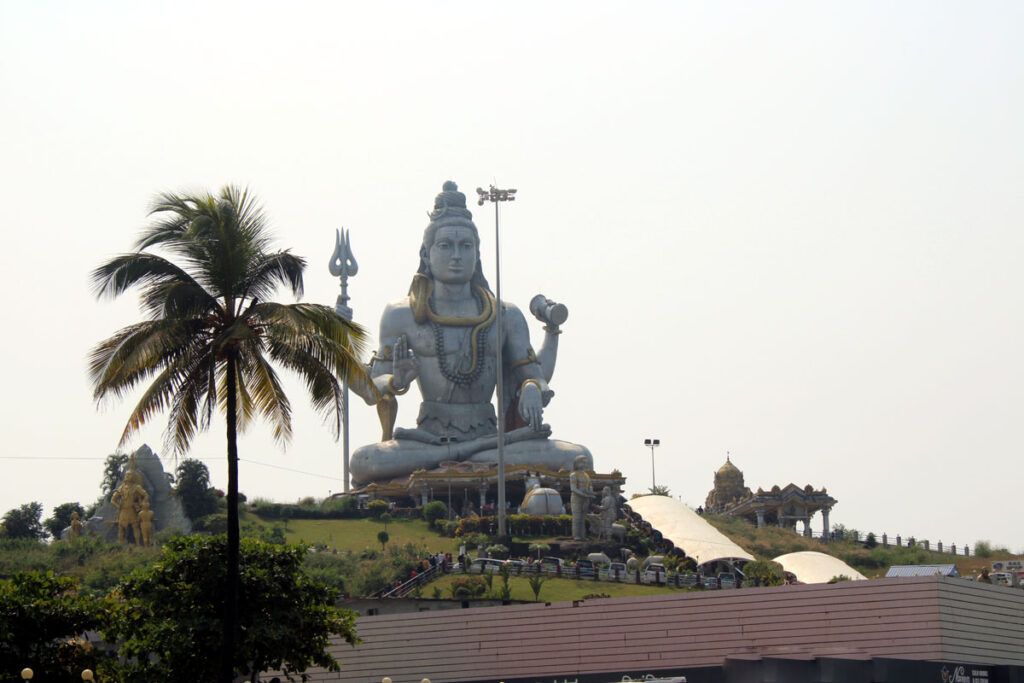
Myths of Murudeshwar Temple Karnataka:
Legend of Ravana and the Atmalinga
One of the most popular myths surrounding the Murudeshwar Temple is the legend of Ravana, the demon king of Lanka. According to the epic Ramayana, Ravana, in an attempt to gain immortality, stole the Atmalinga, a sacred lingam worshipped by Lord Shiva himself. Fearing Shiva’s wrath, Ravana flew towards Lanka, carrying the Atmalinga with him. However, as he reached the coast of Murudeshwar, Lord Shiva intervened. A fierce battle ensued, and Ravana, weakened and defeated, dropped the Atmalinga into the sea. The Atmalinga is said to have washed ashore at Murudeshwar, where it was discovered by local fishermen.
Ravana’s Atmalinga in the Kanduka Hill
Another legend relates to the Kanduka Hill, on which the Murudeshwar Temple is situated. The hill is believed to be the solidified form of Ravana’s Atmalinga. According to this legend, when Ravana dropped the Atmalinga into the sea, it transformed into a giant ball of fire and rolled onto the shore. The fire gradually cooled down, solidifying into a hill, and the Atmalinga remained embedded within it.
The Divine Intervention of Lord Shiva
There are also stories about Lord Shiva’s direct intervention in the construction of the Murudeshwar Temple. One legend narrates that a devout Shiva devotee named Kasyapa was instructed by the Lord in a dream to build a temple at Murudeshwar. Kasyapa, facing many challenges in his task, sought Lord Shiva’s guidance. Lord Shiva is said to have appeared before Kasyapa in the form of a construction worker and assisted him in completing the temple.
The Sacred Nandi
The temple complex also houses a large statue of Nandi, Lord Shiva’s sacred bull. According to legend, Nandi was originally a demon named Nandin, who opposed Lord Shiva. During a fierce battle, Nandin was defeated and transformed into a bull, becoming Lord Shiva’s faithful companion. The Nandi statue at Murudeshwar is believed to possess divine power and is revered by devotees as a symbol of strength and devotion.
Read More>> Panch Kedar Yatra: Ultimate Travel Guide to 5 Divine Shiv Temples
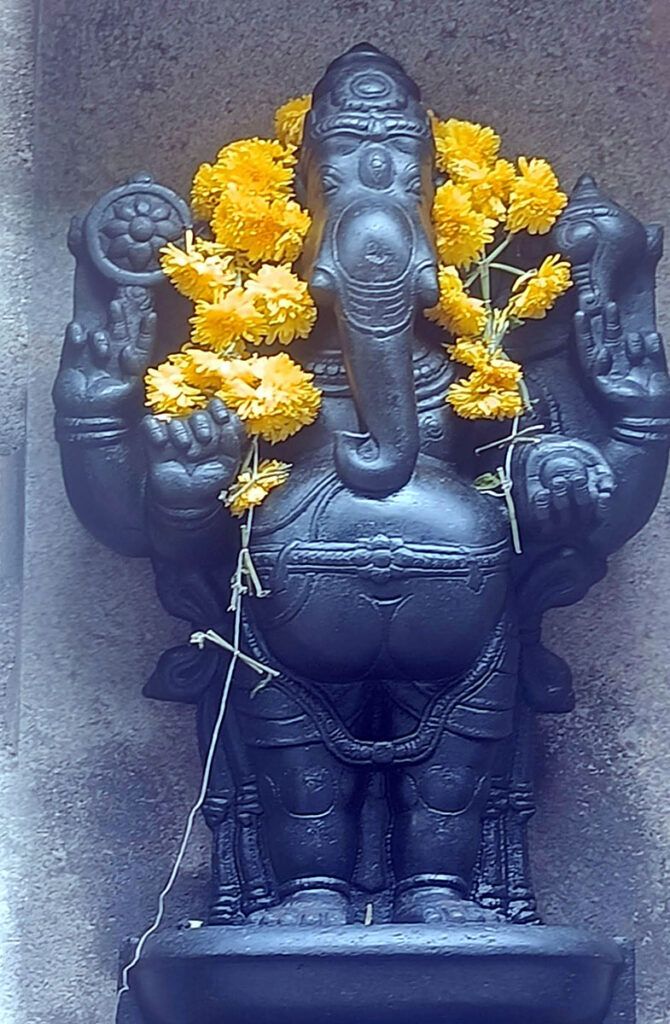
Significance of Murudeshwar Temple Karnataka:
Religious Significance: The temple is dedicated to Lord Shiva, one of the principal deities in Hinduism. The towering statue of Lord Shiva, standing at a height of 123 feet, is the second tallest Shiva statue in the world and a revered symbol of faith for Hindus worldwide.
Historical Significance: The temple’s origins date back to the 7th century AD, with its construction attributed to the Kasapkara, Chalukya, and Vijayanagara dynasties. The temple’s architecture and sculptures reflect the artistic and cultural heritage of these dynasties.
Pilgrimage Site: The Murudeshwar Temple is a major pilgrimage site for Hindus, attracting devotees from India and abroad. The temple’s annual Maha Shivaratri festival is a grand celebration, drawing thousands of pilgrims who partake in rituals and seek blessings from Lord Shiva.
Architectural Marvel: The temple complex is an architectural marvel, showcasing intricate carvings, sculptures, and pillars that depict various Hindu deities and mythological scenes. The temple’s Gopurams (gateway towers) are particularly impressive, adorned with detailed sculptures and rising majestically.
Tourist Attraction: The Murudeshwar Temple is a popular tourist destination, attracting visitors not only for its religious significance but also for its stunning architecture, scenic coastal location, and proximity to other attractions like the Netrani Island.
Read More>> Kotilingeshwara Temple Karnataka: 108 Ft Massive Lingam in the world
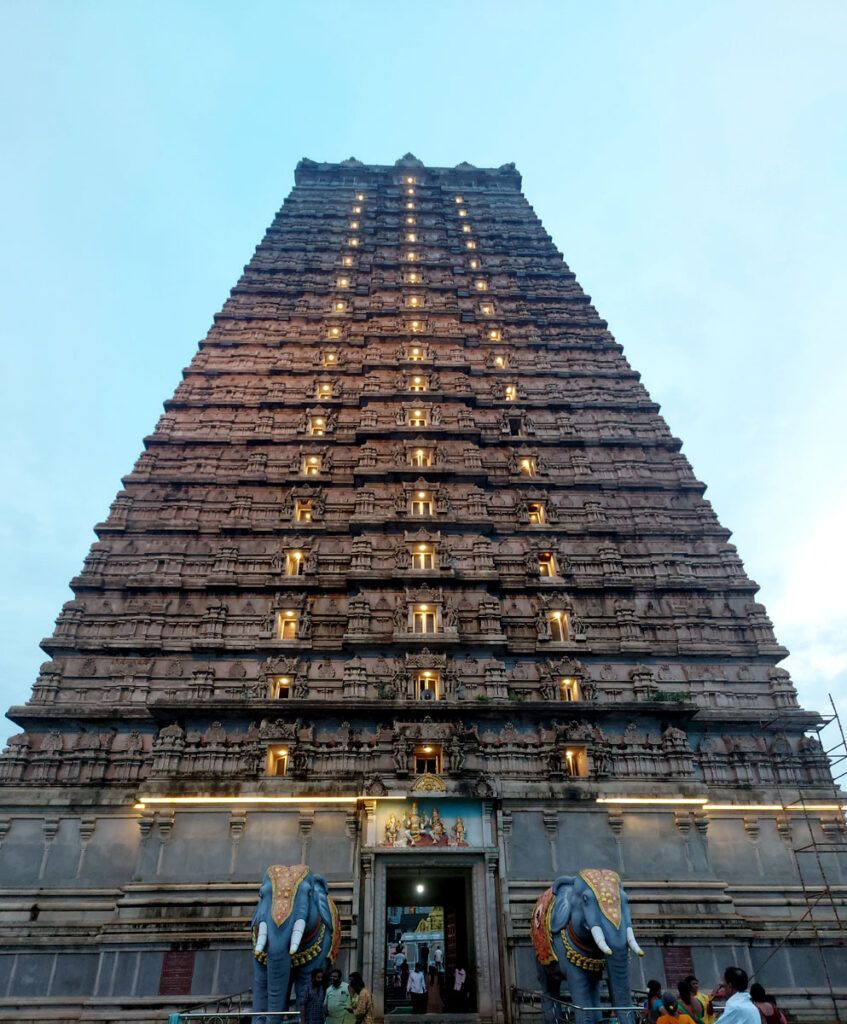
Murudeshwar Temple Timing and Rituals:
Timings
- Morning Darshan: 6:00 AM to 1:00 PM
- Evening Darshan: 3:00 PM to 8:30 PM
Poojas
- Morning Pooja: 6:30 AM to 7:30 AM
- Maha Pooja: 12:15 PM to 1:00 PM
- Night Pooja: 7:15 PM to 8:15 PM
Special Timings during Maha Shivratri
During the Maha Shivratri Festival, the temple timings and the schedule for Aarti/Pooja may undergo alterations. Please refer to the official temple website or local sources for the most up-to-date information during this time.
Rituals
- Darshan: Darshan is the act of seeing and worshipping the deity. Devotees can offer prayers and seek blessings from the deity during darshan.
- Pooja: Puja is a ritual offering to the deity. Devotees can offer flowers, fruits, sweets, and other items during puja.
- Aarti: Aarti is a ritual of offering light to the deity. Devotees can participate in aarti by waving a diya (lamp) around the deity.
Tips for Visiting the Murudeshwar Temple
- Dress modestly. Men should remove their shirts and trousers above the knees. Women should wear sarees or salwar kameezes.
- Remove your footwear before entering the temple.
- Do not carry any bags or cameras inside the temple.
- Do not touch any of the idols or statues inside the temple.
- Be respectful of other devotees.
Read More>> Baidyanath Temple – Sacred Jyotirlinga with Location Dispute
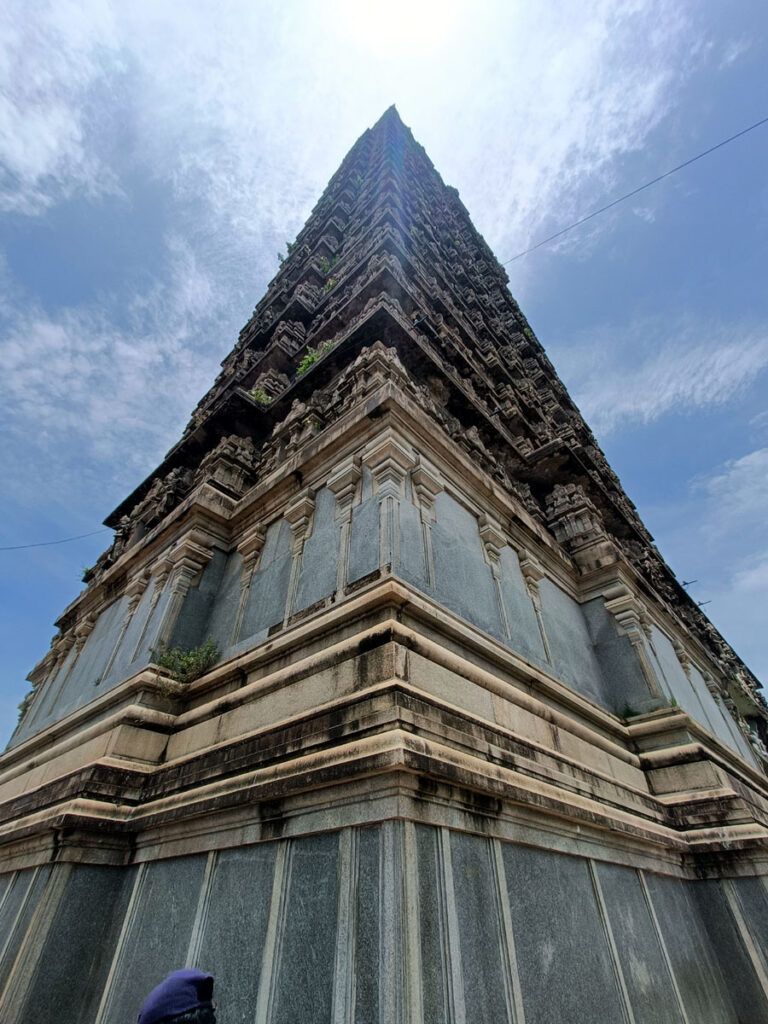
Places to visit near Murudeshwar Temple Karnataka:
- Netrani Island: Also known as Pigeon Island, Netrani is a popular spot for scuba diving and snorkeling. It is located about 19 kilometers from Murudeshwar and offers clear blue waters with diverse marine life.
- Gokarna: Approximately 78 kilometers south of Murudeshwar, Gokarna is a tranquil beach town known for its temples, pristine beaches, and laid-back atmosphere. The Mahabaleshwar Temple and Om Beach are must-visit attractions here.
- Yana: Situated around 55 kilometers from Murudeshwar, Yana is known for its unique limestone rock formations amid dense forests. The Bhairaveshwara Shikhara and Mohini Shikhara are the two main rock formations.
- Kollur: Located about 135 kilometers from Murudeshwar, Kollur is famous for the Mookambika Temple, dedicated to Goddess Mookambika. The temple is situated in the scenic surroundings of the Western Ghats.
- Maravanthe Beach: About 53 kilometers south of Murudeshwar, Maravanthe is known for its picturesque beach with the Arabian Sea on one side and the Souparnika River on the other. The sunset views are spectacular.
- Bhatkal: Approximately 16 kilometers from Murudeshwar, Bhatkal is a historic town with ancient temples, mosques, and a fort. The Jamia Masjid and Jain Basadi are notable landmarks.
- Koodlu Theertha Falls: Located in the Western Ghats, about 120 kilometers from Murudeshwar, this waterfall is surrounded by lush greenery and offers a serene and peaceful atmosphere.
- Mirjan Fort: Situated around 38 kilometers from Murudeshwar, Mirjan Fort is known for its historical significance and architectural beauty. The fort is surrounded by a moat and has intricately carved wooden structures.
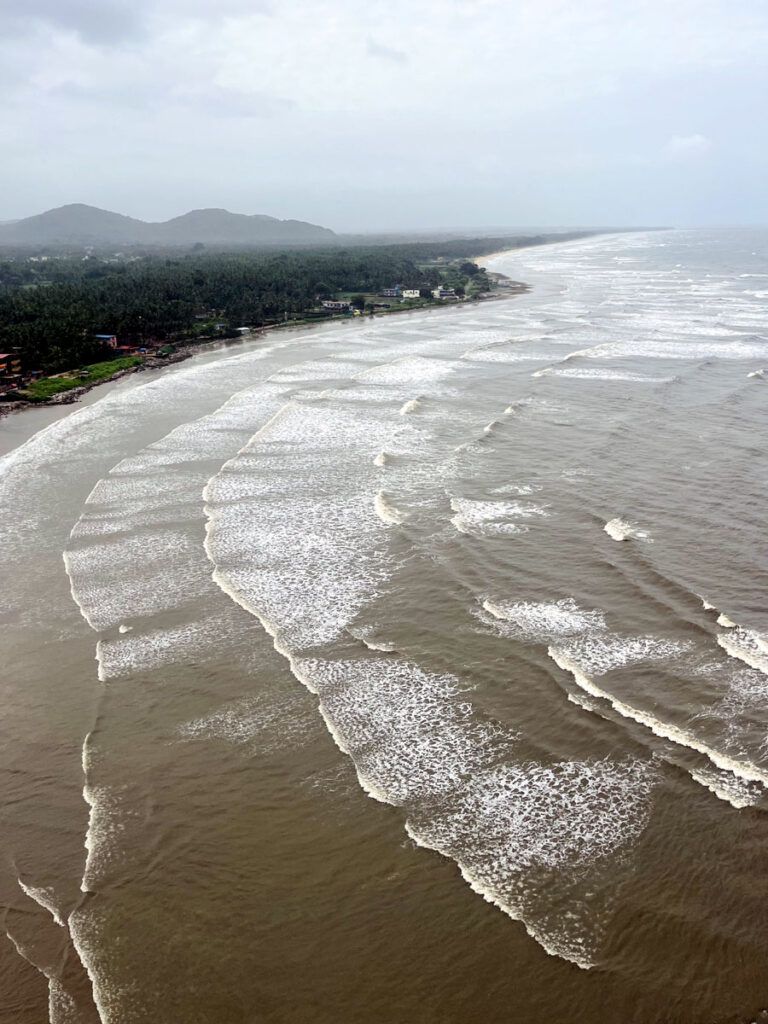
FAQ:
General Information
What is Murudeshwar Temple?
Murudeshwar Temple is a Hindu temple dedicated to Lord Shiva, located in the coastal town of Murudeshwar, Karnataka, India. The temple is famous for its colossal statue of Lord Shiva, which is the second-tallest Shiva statue in the world. The temple complex also houses several other shrines and a cave temple.
Where is Murudeshwar Temple located?
Murudeshwar Temple is located in the town of Murudeshwar, Uttara Kannada district, Karnataka, India. It is situated on the Arabian Sea coast, about 160 kilometers from Mangalore, the nearest major city.
When is Murudeshwar Temple open?
The temple is open from 6:00 AM to 8:30 PM daily.
Is there an entrance fee to visit Murudeshwar Temple?
There is no entrance fee to visit the temple. However, there is a fee of Rs. 10 per person to enter the cave temple.
What are the timings for the abhishekam (sacred bath) performed on the Shiva statue?
The abhishekam is performed on the Shiva statue twice a day, at 6:00 AM and 6:00 PM.
Dress Code
What is the dress code for visiting Murudeshwar Temple?
Visitors are expected to dress modestly. Men should wear full-length pants and shirts, and women should wear sarees or salwar kameez. Shoes are not allowed inside the temple.
Photography
Is photography allowed inside Murudeshwar Temple?
Photography is allowed inside the temple complex, but it is not allowed inside the sanctum sanctorum.
Luggage Storage
Is there a place to store luggage at Murudeshwar Temple?
There is a cloakroom facility available at the temple where visitors can store their luggage for a small fee.
Accomodation
Are there any hotels near Murudeshwar Temple?
Yes, there are several hotels located near the temple. Visitors can choose from a variety of options, ranging from budget-friendly hotels to luxury resorts.
Transportation
How can I reach Murudeshwar Temple?
Murudeshwar Temple is well-connected by road and rail. Visitors can reach the temple by taking a bus or train from Mangalore or Goa. The nearest airport is Mangalore International Airport, which is about 160 kilometers away.
Other Frequently Asked Questions
What is the significance of Murudeshwar Temple?
Murudeshwar Temple is considered one of the most sacred Hindu temples in Karnataka. The temple is believed to have been built in the 13th century by the Kasapara dynasty.
What are some of the other things to see and do in Murudeshwar?
In addition to visiting the temple, visitors can also enjoy the beach, go for a boat ride, or explore the nearby town.
What is the best time to visit Murudeshwar Temple?
The best time to visit Murudeshwar Temple is during the winter months, from October to March.
How many floors Murudeshwar temple has?
The Murudeshwar temple’s Raja Gopura, or grand tower, has 20 floors. It is the second-tallest temple tower in India, after the Brihadeeswarar Temple in Thanjavur, Tamil Nadu. The gopura is made of granite and is adorned with intricate carvings of Hindu deities and mythological scenes. Visitors can climb up the gopura to the 18th floor, where there is an observation deck with panoramic views of the surrounding area.
Is Gokarna and Murudeshwar same?
No, Gokarna and Murudeshwar are two different places located in the state of Karnataka, India. Both are popular pilgrimage destinations, but they have distinct characteristics and attractions.
Gokarna
Gokarna is a coastal town situated in the Uttara Kannada district of Karnataka. It is renowned for its numerous temples and beaches, making it a sacred and serene destination for Hindu devotees and nature enthusiasts alike. The town’s main attraction is the Mahabaleshwara Temple, which is believed to be one of the seven Mukti Sthalas, or places of liberation. Gokarna also boasts several beaches, including the Om Beach, Half Moon Beach, and the Kudle Beach, offering stunning views of the Arabian Sea and opportunities for relaxation and water sports.
Murudeshwar
Murudeshwar, also located in the Uttara Kannada district, is primarily known for the colossal Shiva statue that stands tall on the shores of the Arabian Sea. The statue, measuring 123 feet (37 meters) in height, is the second-tallest Shiva statue in the world. The Murudeshwar Temple complex, surrounding the statue, houses various shrines and a cave temple, making it a significant pilgrimage site. Additionally, Murudeshwar offers attractions like the Kanduka Hill, a natural rock formation resembling a ball, and the Netrani Island, a scenic island known for its rich marine life.
Is dhoti compulsory in Murudeshwar?
While there is no strict dress code enforced at the Murudeshwar Temple, it is customary for men to wear dhotis or mundus, and for women to wear sarees or salwar kameez. This is a sign of respect for the sanctity of the temple and its traditions. Shorts, sleeveless tops, and revealing clothing are not allowed.
Here is a summary of the recommended dress code for visiting Murudeshwar Temple:
- Men: Dhoti or mundu (traditional Indian attire), shirt or kurta (traditional Indian top), and angavastram (shoulder cloth)
- Women: Saree, salwar kameez (traditional Indian attire), or a long dress that covers the shoulders and knees
- Footwear: Shoes are not allowed inside the temple. There are designated areas where visitors can leave their shoes before entering.
What is special about Murudeshwar Temple?
Murudeshwar Temple in Karnataka, India, is renowned for its towering statue of Lord Shiva, the second-tallest in the world, standing at a majestic 123 feet (37 meters). This awe-inspiring statue, along with the temple’s intricate carvings, sculptures, and gopurams (tower gateways), showcase the region’s artistic brilliance and architectural heritage. The temple complex also houses various shrines, including the sacred Atma Linga Sanctum Sanctorum, making it a revered pilgrimage site for Hindus worldwide.
How to reach Murudeshwar Temple Karnataka:
By Air:
The nearest airport to Murudeshwar is Mangalore International Airport (IXE), which is approximately 153 kilometers away. From the airport, you can hire a taxi or take a bus to reach Murudeshwar.
By Train:
Murudeshwar has its own railway station, Murudeshwar Railway Station (MRE). It is well-connected to major cities in Karnataka and other parts of India. You can check the train schedules and book tickets to Murudeshwar.
By Road:
- From Mangalore:
- The distance from Mangalore to Murudeshwar is around 156 kilometers. You can take NH66 (National Highway 66) towards Udupi and then continue on NH66 to reach Murudeshwar.
- From Bangalore:
- The distance from Bangalore to Murudeshwar is approximately 491 kilometers. You can take NH48 (National Highway 48) towards Mangalore, and then switch to NH66 towards Murudeshwar.
- From Goa:
- If you are coming from Goa, you can take NH66 towards Karwar and then continue on the same highway to reach Murudeshwar.
- By Bus:
- Murudeshwar is well-connected by road, and you can find both government and private buses operating from major cities in Karnataka to Murudeshwar. Bus services are available from Mangalore, Bangalore, and other nearby towns.
- Local Transportation:
- Once you reach Murudeshwar, you can use local transportation such as auto-rickshaws or taxis to reach the Murudeshwar Temple.
For more details regarding accommodation and other facilities please visit the Karnataka tourism website.
